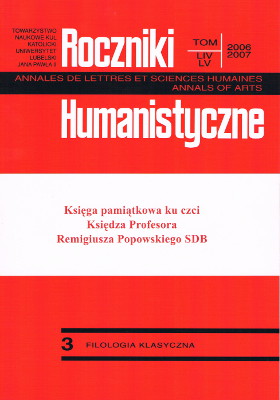Two Ancient Traditions to Represent the Human Body in Mediaeval Art
Abstract
In the basic system of visual arts the human body is subject to the first interpretations, artistic and semantic evaluations. In the studies on art it was the principal criterion of style and artist’s workshop. In the most ancient research on early medieval art and the mature Middle Ages the stylistic definitions of the human body were assumed to be the basis of the classification of art, its relationship with ancient tradition or its various divergences, which were given pejorative names. The classical character of divergences from that model in the context modelling the body allows us to establish the chronology of works from the times of the fall of pagan art up to the new forms of Christian art.
An interesting study on the human body (not on nakedness) help us to take a closer look on how Roman art, especially French sculpture, was established in the circle of Benedictine orders. Starting from the classical model of Mediterranean art it created a new understanding of the body in accord with the strict text of the Bible, which — instead of corporeal unity — stressed the importance of its members. An analysis of particular excerpts from the Bible, providing the sense of the hip, the knee, the eye, the head, and the hand allow us to explain the analysis of the body into its members often called deformation. Some examples of monumental sculpture in Moissac, Cluny, and Wezelay unveil the sense of this deformation in the Judaic, not Roman, context of understanding the body. Italy and its influence have retained the Mediterranean, Roman traditions in the shaping of the human body. Thereby they continued the classical model for Gothic art and sculpture in the cathedral milieus. The body and the wealth of its corporeality is shown by sculpture returning to the Roman model again, thereby unveiling the scale of psychological values, such as smile, depicted in the sculptures in Reims, Naumburg, and Lincoln. We may notice in medieval art two patterns by which to show the body: classical and Judaic that comes from the Bible.
References
Aubert M.: L’art romain en France, Paris: B. Arthaud 1988.
Belting H.: Likeness and Presence. A History of the Image before the Era of Art, Chicago–London: University of Chicago Press 1994.
Binski P.: The Angel Choir at Lincoln and the Poetics of the Gothic Smile, „Art History” 20 (1997), s. 350-375.
Eliot T. S.: Kto to jest klasyk i inne eseje, przeł. M. Heydel, M. Niemojewska, Kraków: Znak 1998.
Elsner J.: Art and the Roman Viewer. The Transformation of Art from the Pagan World to Christianity, Cambridge: Cambridge University Press 1995.
Flanagan S.: Hildegarda z Bingen. Żywot wizjonerki, przeł. R. Sudół, Warszawa: PIW 2002.
Guriewicz A.: Jednostka w dziejach Europy (Średniowiecze), przeł. Z. Dobrzyniecki, przedmowa J. Le Goff, Gdańsk–Warszawa: Wyd. Marabut 2002.
Hamann-Mac Lean R. H. L.: Antikenstudium in der Kunst des Mittelalters, [w:] Stilwandel und Persönlichkeit. Gesammelte Aufsatze, Stuttgart 1988.
Jaeger W.: Wczesne chrześcijaństwo i grecka paideia, Przekład i redakcja K. Bielawski, Bydgoszcz: Homini 2002.
Jeauneau E.: La lecture des auteurs classiques à l’école de Chartres durant la première moitié du XIIe siècle. Un témoin privilégié: ‘Les Glosae super Macrobium’ de Guillaume de Conches, [w:] Classical Influences on European Culture, Cambridge: Cambridge University Press 1971, s. 95-111.
Katzenellenbogen A.: The Sculptural Programs of Chartres Cathedral. Christ. Mary. Ecclesia, New York–London 1964.
Kozłowska A.: Średniowieczne traktaty De natura corporis humani, „Studia Warmińskie” 39 (1992), s. 84-97.
Krąpiec M. A.: Ja – Człowiek. Zarys antropologii filozoficznej, Lublin: TN KUL 1974.
Kurdziałek M.: Koncepcje człowieka jako mikrokosmosu, [w:] O Bogu i o człowieku. Problemy filozoficzne, pod red. B. Bejze, t. 2, Warszawa 1968, s. 109-125.
Kurdziałek M.: Średniowiecze w poszukiwaniu równowagi między arystotelizmem a platonizmem. Studia i artykuły, Lublin: TN KUL 1996.
Le Goff J., Truong N.: Historia ciała w średniowieczu, przeł. I. Kania, Warszawa: Czytelnik 2006.
Le Gof f J.: Człowiek średniowiecza, przeł. M. Radożycka-Paoletti, Warszawa: Marabut 1996.
Le Gof f J.: Kultura średniowiecznej Europy, przeł. H. Szumańska-Grossowa, Warszawa: Wyd. Naukowe PWN 2002.
Maślanka-Soro M.: Tragizm w Komedii Dantego, Kraków 2005.
Mazurczak M.: Obraz Miłosiernego Boga w tympanonie katedry w Chartres, „Acta Mediaevalia” 2004, nr 17, s. 84-97.
Menard P.: Le Rire et le sourire dans le roman courtois en France au Moyen Age (1150-1250), Geneva 1969.
Panofsky E.: Renaissance and Renascences in Western Art, Stockholm: Suhrkamp 1960.
Panofsky E.:Die Renaissancen der europäischen Kunst, Frankfurt am Main: Suhrkamp 1979.
Pochat G.: Das Fremde im Mittelalter. Darstellung in Kunst und Literatur, Würzburg: W. de Gruyter 1997.
Property and Power in the Early Middle Ages, edd. W. Davies, P. Fourace, Cambridge: Cambridge University Press 1995.
Schleusener-Eichol z G.: Das Auge im Mittelalter, t. 1-2, München: W. Fink Verlag 1985.
Schlink W.: Existait-il un programme d’ensemble pour les cathédrales au Moyen Age?, [w:] Les monde cathédrales. Cycle de conférences organisé par le Musée du Louvre du 6 janvier au 24 février 2000, Paris-Louvre 2003, s. 13-41.
Schreiner J.: Teologia Starego Testamentu, przeł. B. W. Matysiak, Warszawa: Adam 1999.
Southern R. W.: The Making of the Middle Ages, London: Hutchinson 1967. Pol.: Kształtowanie średniowiecza, przeł. H. Pręczkowska, Warszawa: PIW 1970
Św. Tomasz, Suma teologiczna, t. 7, cz. 2: Człowiek, 1, 85-102. Przeł. i objaśnieniami zaopatrzył P. Bełch OP, Londyn: Veritas 1980.
Vitali S.: Sicut explorator et spoliorum cupidus: Zu Methode und Funktion der Antikenrezeption bei Nikolaus von Verdun, „Wiener Jahrbuch für Kunstgeschichte” 52 (2002), s. 10-47.
Winkler Ch.: Die Maske des Bösen. Groteske Physiognomie als Gegenbild des Heiligen und Vollkommenen in der Kunst des 15. und 16. Jahrhunderts, München 1986.
Copyright (c) 2007 Roczniki Humanistyczne

This work is licensed under a Creative Commons Attribution-NonCommercial-NoDerivatives 4.0 International License.





